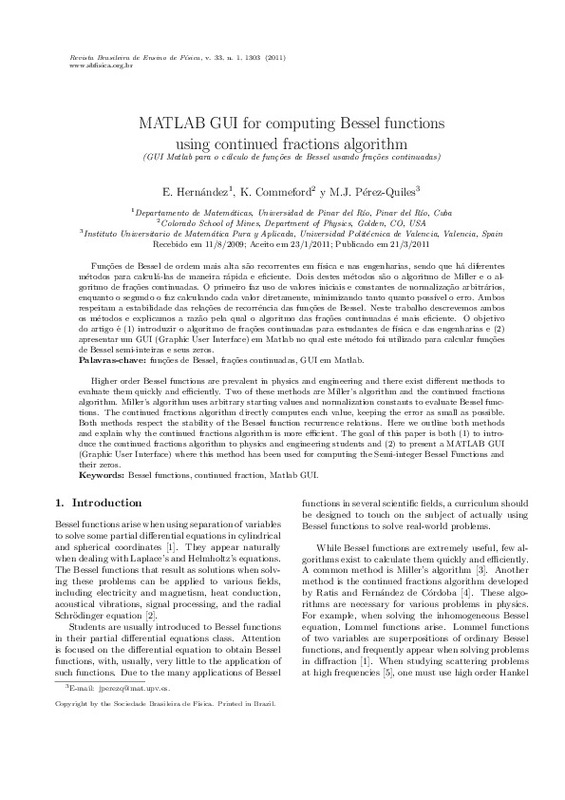JavaScript is disabled for your browser. Some features of this site may not work without it.
Buscar en RiuNet
Listar
Mi cuenta
Estadísticas
Ayuda RiuNet
Admin. UPV
MATLAB GUI for computing Bessel functions using continued fractions algorithm
Mostrar el registro sencillo del ítem
Ficheros en el ítem
| dc.contributor.author | Hernandez Vargas, E.
|
es_ES |
| dc.contributor.author | Commeford, K.
|
es_ES |
| dc.contributor.author | Pérez Quiles, María Jezabel
|
es_ES |
| dc.date.accessioned | 2020-03-01T21:01:45Z | |
| dc.date.available | 2020-03-01T21:01:45Z | |
| dc.date.issued | 2011 | es_ES |
| dc.identifier.issn | 1806-1117 | es_ES |
| dc.identifier.uri | http://hdl.handle.net/10251/138035 | |
| dc.description.abstract | [EN] Higher order Bessel functions are prevalent in physics and engineering and there exist different methods to evaluate them quickly and efficiently. Two of these methods are Miller's algorithm and the continued fractions algorithm. Miller's algorithm uses arbitrary starting values and normalization constants to evaluate Bessel functions. The continued fractions algorithm directly computes each value, keeping the error as small as possible. Both methods respect the stability of the Bessel function recurrence relations. Here we outline both methods and explain why the continued fractions algorithm is more efficient. The goal of this paper is both (1) to introduce the continued fractions algorithm to physics and engineering students and (2) to present a MATLAB GUI (Graphic User Interface) where this method has been used for computing the Semi-integer Bessel Functions and their zeros. | es_ES |
| dc.description.abstract | [PT] Funções de Bessel de ordem mais alta são recorrentes em física e nas engenharias, sendo que há diferentes métodos para calculá-las de maneira rápida e eficiente. Dois destes métodos são o algoritmo de Miller e o algoritmo de frações continuadas. O primeiro faz uso de valores iniciais e constantes de normalização arbitrários, enquanto o segundo o faz calculando cada valor diretamente, minimizando tanto quanto possível o erro. Ambos respeitam a estabilidade das relações de recorrência das funções de Bessel. Neste trabalho descrevemos ambos os métodos e explicamos a razão pela qual o algoritmo das frações continuadas é mais eficiente. O objetivo do artigo é (1) introduzir o algoritmo de frações continuadas para estudantes de física e das engenharias e (2) apresentar um GUI (Graphic User Interface) em Matlab no qual este método foi utilizado para calcular funções de Bessel semi-inteiras e seus zeros. | es_ES |
| dc.description.sponsorship | The authors wish to thank the financial support received from the Universidad Politécnica de Valencia under grant PAID-06-09-2734, from the Ministerio de Ciencia e Innovación through grant ENE2008-00599 and specially from the Generalitat Valenciana under grant reference 3012/2009. | es_ES |
| dc.language | Inglés | es_ES |
| dc.publisher | SciELO | es_ES |
| dc.relation.ispartof | Revista Brasileira de Ensino de Física | es_ES |
| dc.rights | Reconocimiento - No comercial (by-nc) | es_ES |
| dc.subject | Funções de Bessel | es_ES |
| dc.subject | Frações continuadas | es_ES |
| dc.subject | GUI em Matlab | es_ES |
| dc.subject | Bessel functions, continued fraction, Matlab GUI | es_ES |
| dc.subject.classification | MATEMATICA APLICADA | es_ES |
| dc.title | MATLAB GUI for computing Bessel functions using continued fractions algorithm | es_ES |
| dc.title.alternative | GUI Matlab para o cálculo de funções de Bessel usando frações continuadas | es_ES |
| dc.type | Artículo | es_ES |
| dc.identifier.doi | 10.1590/S1806-11172011000100003 | es_ES |
| dc.relation.projectID | info:eu-repo/grantAgreement/UPV//PAID-06-09-2734/ | es_ES |
| dc.relation.projectID | info:eu-repo/grantAgreement/GVA//GV%2F3012%2F2009/ | es_ES |
| dc.relation.projectID | info:eu-repo/grantAgreement/MICINN//ENE2008-00599/ES/MODELADO, SIMULACION Y VALIDACION EXPERIMENTAL DE LA TRANSFERENCIA DE CALOR EN EL ENTORNO DE LA EDIFICACION/ | es_ES |
| dc.rights.accessRights | Abierto | es_ES |
| dc.contributor.affiliation | Universitat Politècnica de València. Departamento de Matemática Aplicada - Departament de Matemàtica Aplicada | es_ES |
| dc.description.bibliographicCitation | Hernandez Vargas, E.; Commeford, K.; Pérez Quiles, MJ. (2011). MATLAB GUI for computing Bessel functions using continued fractions algorithm. Revista Brasileira de Ensino de Física. 33(1):1303-1311. https://doi.org/10.1590/S1806-11172011000100003 | es_ES |
| dc.description.accrualMethod | S | es_ES |
| dc.relation.publisherversion | https://doi.org/10.1590/S1806-11172011000100003 | es_ES |
| dc.description.upvformatpinicio | 1303 | es_ES |
| dc.description.upvformatpfin | 1311 | es_ES |
| dc.type.version | info:eu-repo/semantics/publishedVersion | es_ES |
| dc.description.volume | 33 | es_ES |
| dc.description.issue | 1 | es_ES |
| dc.relation.pasarela | S\222051 | es_ES |
| dc.contributor.funder | Universitat Politècnica de València | es_ES |
| dc.contributor.funder | Ministerio de Ciencia e Innovación | es_ES |
| dc.contributor.funder | Generalitat Valenciana | es_ES |
| dc.description.references | Giladi, E. (2007). Asymptotically derived boundary elements for the Helmholtz equation in high frequencies. Journal of Computational and Applied Mathematics, 198(1), 52-74. doi:10.1016/j.cam.2005.11.024 | es_ES |
| dc.description.references | Havemann, S., & Baran, A. J. (2004). Calculation of the phase matrix elements of elongated hexagonal ice columns using the T-matrix method. Journal of Quantitative Spectroscopy and Radiative Transfer, 89(1-4), 87-96. doi:10.1016/j.jqsrt.2004.05.014 | es_ES |
| dc.description.references | Segura, J., Fernández de Córdoba, P., & Ratis, Y. L. (1997). A code to evaluate modified bessel functions based on thecontinued fraction method. Computer Physics Communications, 105(2-3), 263-272. doi:10.1016/s0010-4655(97)00069-6 | es_ES |
| dc.description.references | Bastardo, J. L., Abraham Ibrahim, S., Fernández de Córdoba, P., Urchueguía Schölzel, J. F., & Ratis, Y. L. (2005). Evaluation of Fresnel integrals based on the continued fractions method. Applied Mathematics Letters, 18(1), 23-28. doi:10.1016/j.aml.2003.12.009 | es_ES |
| dc.description.references | Barnett, A. R., Feng, D. H., Steed, J. W., & Goldfarb, L. J. B. (1974). Coulomb wave functions for all real η and ϱ. Computer Physics Communications, 8(5), 377-395. doi:10.1016/0010-4655(74)90013-7 | es_ES |








